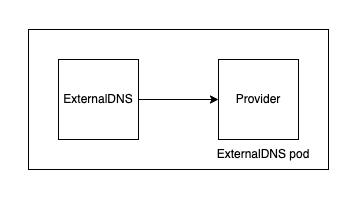Webhook provider¶
The “Webhook” provider allows integrating ExternalDNS with DNS providers through an HTTP interface.
The Webhook provider implements the Provider interface. Instead of implementing code specific to a provider, it implements an HTTP client that sends requests to an HTTP API.
The idea behind it is that providers can be implemented in separate programs: these programs expose an HTTP API that the Webhook provider interacts with. The ideal setup for providers is to run as a sidecar in the same pod of the ExternalDNS container, listening only on localhost. This is not strictly a requirement, but we do not recommend other setups.
Architectural diagram¶

API guarantees¶
Providers implementing the HTTP API have to keep in sync with changes to the JSON serialization of Go types plan.Changes, endpoint.Endpoint, and endpoint.DomainFilter. Given the maturity of the project, we do not expect to make significant changes to those types, but can’t exclude the possibility that changes will need to happen. We commit to publishing changes to those in the release notes, to ensure that providers implementing the API can keep providers up to date quickly.
Implementation requirements¶
The following table represents the methods to implement mapped to their HTTP method and route.
| Provider method | HTTP Method | Route |
|---|---|---|
| Records | GET | /records |
| AdjustEndpoints | POST | /adjustendpoints |
| ApplyChanges | POST | /records |
| K8s probe | GET | /healthz |
ExternalDNS will also make requests to the / endpoint for negotiation and for deserialization of the DomainFilter.
The server needs to respond to those requests by reading the Accept header and responding with a corresponding Content-Type header specifying the supported media type format and version.
The default recommended port is 8888, and should listen only on localhost (ie: only accessible for k8s probes and external-dns).
NOTE: only 5xx responses will be retried and only 20x will be considered as successful. All status codes different from those will be considered a failure on ExternalDNS’s side.
Metrics support¶
The metrics should listen “:8080” on /metrics following Open Metrics format.
Provider registry¶
To simplify the discovery of providers, we will accept pull requests that will add links to providers in the README file. This list will only serve the purpose of simplifying finding providers and will not constitute an official endorsement of any of the externally implemented providers unless otherwise stated.
Run an ExternalDNS in-tree provider as a webhook.¶
To test the Webhook provider and provide a reference implementation, we added the functionality to run ExternalDNS as a webhook. To run the AWS provider as a webhook, you need the following flags:
The value of the --source flag is ignored in this mode.
This will start the AWS provider as an HTTP server exposed only on localhost.
In a separate process/container, run ExternalDNS with --provider=webhook.
This is the same setup that we recommend for other providers and a good way to test the Webhook provider.